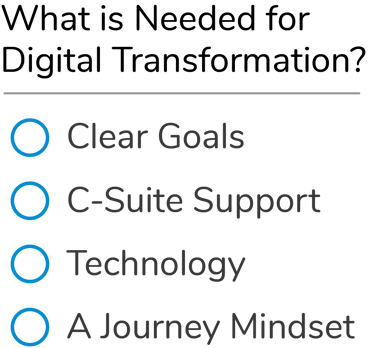Why is Digital Transformation So Important?
December 3, 2019 •DJ Team

Before the Internet and the World Wide Web, sending mail involved paper and envelopes, taking a photo required film, and shopping meant going to a store or buying through a mail order catalog. Now though, email, mega-pixel cameras, and eCommerce have moved those activities into the digital realm. These simple examples of digital transformation have profoundly affected our real-world activities, our behavior and our culture. For that reason alone, the importance of digital transformation in business can hardly be overstated.
What Is Digital Transformation?
Digital transformation has been defined in many ways. CIO Magazine suggests it's “a necessary disruption” — a complete reshaping of business processes with the goal of improving business outcomes. Not to be confused with simpler projects, such as adding cloud computing to the corporate IT infrastructure, digital transformation radically changes how things get done. It affects employees, customers and other stakeholders alike.
Another definition sees digital transformation as the integration of digital technologies into a business to change how it operates and how it delivers value to customers. In this view, it's a cultural change within the company that asks the business to continuously work toward delivering more value to customers.
No matter how it's defined, the benefits of digital transformation, and the reasons most companies undertake such efforts, are three in number: to increase profitability, to increase customer satisfaction, and to increase speed-to-market.
What Does Digital Transformation Do?
In a sense, you can divide the impact of digital transformation into a “demand side” and a “supply side.”
- People are the users of digital technology, and they represent the demand side.
- Businesses around the world represent the supply side when they provide software and hardware that replace traditional ways of living and working with improved, digital methods.
An example of the demand side: The first commercial email program, Eudora, was launched in 1988. Since then, email has become ubiquitous and most people rely on it today. Email, VoiP, SMS, video chats — and digital transformation in general — have increased access to cheap and effective communication. They've given billions of people the ability to communicate worldwide at nominal cost.
Likewise, eCommerce has given rise to nearly countless e-stores and to a complete makeover of the retail market, thanks especially to Amazon's aggressive embrace of digital technology. eCommerce has led to events like Black Friday and Cyber Monday. It's led to the closing of thousands of brick and mortar stores and to popular demands to support local businesses. eCommerce has revolutionized the retail market and the pace of change only continues to accelerate.
There's hardly a segment of society that hasn't been affected by digital transformation. Some have referred to this era as “the fourth industrial revolution.”
Businesses have been drawn into digital transformation for three primary reasons.
- First, technology advancements made certain actions faster, easier and less costly when done through digital means.
- Second, companies realized they could give their customers a more satisfying experience by offering digital methods to, let's say, buy a product, pay a bill, or schedule an appointment.
- Third, as companies began their digital transformations, competitors realized they had to “transform or die.”

The global consulting and marketing firm IDC predicted worldwide spending on digital transformation to reach $1.18 trillion in 2019, a nearly 18 percent increase over 2018, and more than $6 trillion by 2024.
 At the same time, Telestra, an Australian telecom company, surveyed more than 3,800 decision makers and executives in 2019 to discover what works and what doesn’t work as companies move toward digital transformation. They found only one in five companies (21 percent) consider themselves “digitally mature,” while just 24 percent say they’ve integrated a transformation throughout their organization.
At the same time, Telestra, an Australian telecom company, surveyed more than 3,800 decision makers and executives in 2019 to discover what works and what doesn’t work as companies move toward digital transformation. They found only one in five companies (21 percent) consider themselves “digitally mature,” while just 24 percent say they’ve integrated a transformation throughout their organization.
The McKinsey management consulting firm further points out that only about one in six companies (16 percent) are able to report that their transformational efforts improved business performance, and that they expected such improvements to continue over the long haul. Another 7 percent reported they obtained improvements in the short term but could not maintain them.
What Is Needed for Digital Transformation?
Pundits have written volumes on how to do digital transformation. They’ve covered the resources needed, the steps to take, and the pitfalls to avoid when launching a digital transformation. While they've listed many “must do” items, much of their counsel focuses on a few key areas that include:

- Clear goals. A transformational effort can only be successful when clear, measurable goals are established at the outset.
- C-suite support. A successful transformation needs to be led from the top down.
- Technology. Most agree that a successful transformation project will usually involve cloud computing, IoT, artificial intelligence, and big data analytics.
- Cultural issues. Employees and other stakeholders must be engaged and supportive of the new business processes a transformation will create. Gartner suggests that Change Management must become a part of digital transformation
- A journey, not a destination. “To transform” implies there is a destination, which is incorrect in the context here. Those involved in a transformative effort must acknowledge that transformation is not a “once and done” project. It's ongoing and continuous.
In Conclusion
Designing and implementing a plan to transform traditional business processes into digital actions isn’t for the faint of heart. Yet, to survive and prosper in today’s fast-moving digital world, it’s essential that companies retool with a sharp focus on the customer and customer satisfaction.
DemandJump can help by showing you more of your customer's journey and competitive landscape than you’ve ever seen before. You’ll see what your customers are doing, what your competition is doing, and most importantly, what you should be doing next.
Featured Articles
Categories
- Attribution Tracking (13)
- Channel Optimization (11)
- Consumer Insights (68)
- Content Marketing (251)
- Data Science (8)
- Digital Marketing (6)
- Digital Transformation (26)
- Enterprise (10)
- Lead Generation (14)
- Market Intelligence (8)
- Marketing Analytics (39)
- Marketing Attribution (57)
- Marketing Management (153)
- Marketing Operations (86)
- Organic Search (222)
- Paid Search (52)
- Pillar-Based Marketing (63)
- Programmatic Advertising (9)
- SaaS Content (14)
- SaaS Marketing (29)
- Search Marketing (111)
- SEO Keyword Research (28)
- SEO Pillar (18)
- SEO Strategy (46)
- SMB (5)
- Website Content (12)

